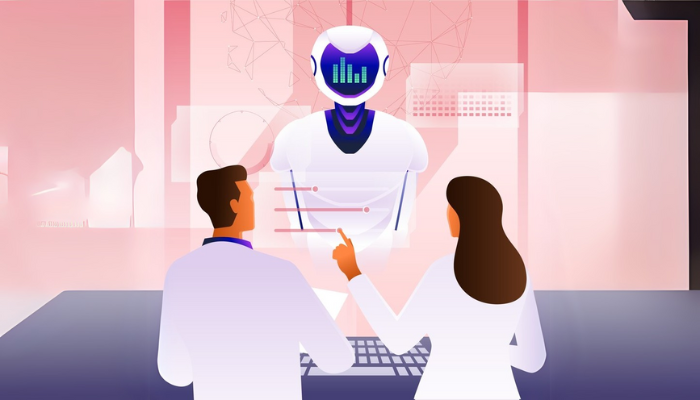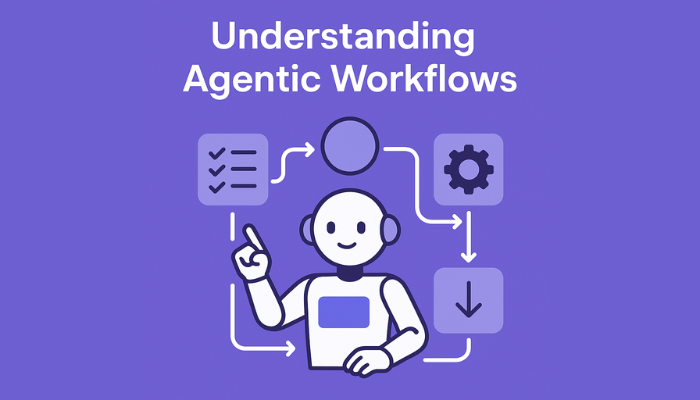Ever felt overwhelmed by repetitive tasks like replying to endless customer queries, analyzing spreadsheets, or switching between multiple tools just to complete a workflow? You’re not alone. These bottlenecks drain time, cause errors, and reduce focus from strategic work. Enter AI agents. In simple words, they’re smart software systems that can make decisions, take actions, and learn from their environment—with little to no human intervention.
The global artificial intelligence market size was estimated at USD 279.22 billion in 2024 and is expected to reach USD 390.90 billion in 2025 showing how fast AI technologies, including AI agents, are growing.
This blog offers a clear look at AI agents—how they think, act, and support decision-making. If you’re trying to understand how smart systems are reshaping industries and customer interactions, this blog will answer your questions in simple terms.
Let us begin by understanding what an AI agent is.
What Is an AI Agent?
An AI agent is a software entity designed to observe its environment, process inputs, make informed decisions, and perform actions to fulfill a specific objective—all without human intervention. These systems are purpose-built to act autonomously, whether it’s responding to user queries, analyzing large datasets, or initiating a workflow based on context.
In simple terms, an AI agent behaves like a digital worker. It’s not just responding to inputs—it’s actively identifying problems, prioritizing solutions, and executing tasks based on goals.
Where traditional chatbots follow scripted conversations, AI agents act with intent. Chatbots often rely on pre-defined flows and struggle outside of those paths. AI agents, on the other hand, assess their environment—whether it’s user input, API data, or third-party triggers—and determine the most effective course of action.
Take Botpress as an example. It doesn’t just wait for a specific keyword. Instead, it processes user inputs using powerful large language models (LLMs), understands intent, evaluates context, and selects tools or workflows to get the job done. This makes AI agents not just reactive—but proactive. They can handle multi-turn conversations, manage tasks in parallel, and work across systems, all without being explicitly told what to do next.
AI Agents vs. Traditional Chatbots vs. Digital Assistants
In the world of intelligent systems, the term AI agent is gaining traction as businesses and users look for smarter, more responsive solutions. But what is an AI agent, and how does it differ from traditional chatbots and digital assistants? Here’s a quick comparison to help understand the shift in how machines are designed to interact, respond, and think.
| Feature | Traditional Chatbots | Digital Assistants | AI Agents |
| Behavior | Rule-based, predefined scripts | Mostly task-focused with basic learning | Goal-oriented, proactive, autonomous |
| Context Handling | Weak or none | Limited to session | Strong memory and context awareness |
| Adaptability | Low | Moderate | High-can re-plan actions based on new inputs |
| Actions Performed | Respond to queries | Perform basic tasks (set reminders etc.) | Execute complex workflows, make decisions |
| Learning Capabilities | None | Some | Full learning loop via ML models or human feedback |
| Example | FAQ bot on a website | Google Assistant, Siri | HR bot that screens resumes and schedules interview |
Must Read: Why AI is Getting Trendy
Core Components of AI Agent Architecture
To truly understand what is an AI agent, it’s essential to break down the architecture that powers its functionality. AI agents aren’t just LLM-powered interfaces—they are structured systems built with defined roles, rules, and resources to process data, perform actions, and deliver outcomes.
Each agent is made up of several interlocking components, all of which contribute to how it interacts with users, handles tasks, and adapts over time.
1. LLM Routing
At the core of AI agents is their ability to understand and produce natural language using large language models (LLMs). But routing is what makes them task-oriented. LLM routing determines which model (or model instruction set) should be used based on the user’s intent, context, or task. This ensures responses are not only linguistically correct but operationally accurate. For instance, a customer support agent might route inquiries about refunds to a different sub-agent with financial rules encoded.
2. Identity and Instructions
Every AI agent must have a well-defined identity, including its function, tone of voice, operational boundaries, and intended outcome. Think of this as a job description programmed into the system. For example, an HR assistant agent might be instructed to remain strictly policy-based, avoid casual dialogue, and refer unresolved queries to human reps. This clarity shapes the consistency and accuracy of the agent’s decisions.
3. Tools
AI agents go beyond answering queries—they perform actions by connecting to external tools and APIs. These tools might include scheduling apps, CRMs, inventory databases, or payment gateways. Agents use these integrations to complete workflows. For example, a sales agent may pull real-time inventory data, place an order, and send confirmation—all triggered by a single user request.
4. Memory and Knowledge
Short-term and long-term memory are fundamental for agents to function coherently. Memory enables agents to hold on to contextual information during conversations, while knowledge bases (or external embeddings) provide them with persistent facts or references.
5. Channels
AI agents are expected to show up where users are. Whether that’s on a website chat window, WhatsApp, Microsoft Teams, or a mobile app, channel configuration ensures the agent functions correctly across environments.
6. Governance
AI agents must operate within clear boundaries—ethical, operational, and legal. Governance includes data handling policies, escalation protocols, decision thresholds, and compliance safeguards. For example, an AI agent in healthcare must follow HIPAA guidelines while responding to patient queries. Admin dashboards, like those provided by Codewave, give product owners visibility into performance, usage logs, and policy enforcement, making sure AI doesn’t go off script.
While the architecture defines how an agent operates, understanding the difference, the different types of AI agents gives clarity on how they function in various roles and industries.
As AI technology continues to grow more intelligent and responsive, understanding the types of AI agents becomes even more important.
Also Read: Applications of Artificial Intelligence in Business
Types of AI Agents
AI agents can be grouped based on their decision-making style, ability to learn, and how they interact with their environment and other agents. Here are mainly 5 types of AI Agents:
1. Reactive Agents
Reactive agents are the simplest form of AI agents. They operate solely based on current input without storing past interactions or building any internal model of the world. These agents follow a straightforward stimulus-response approach, making them highly efficient in time-sensitive scenarios. However, they lack the ability to adapt or learn from experience. A good example is a rule-based chatbot that answers customer FAQs—fast and consistent, but unaware of previous messages or broader context.
2. Deliberative Agents
Deliberative agents work on a more thoughtful level. They rely on an internal representation or model of their environment, which they use to interpret inputs, evaluate various actions, and predict outcomes before making a decision. This allows them to perform complex reasoning tasks such as planning, diagnostics, or problem-solving. For example, a logistics assistant that considers inventory levels, shipping times, and cost to suggest the best delivery method uses a deliberative approach.
3. Learning Agents
Learning agents are designed to improve over time through experience. They collect feedback from their actions and use this information to refine their behavior, typically using machine learning algorithms. These agents do not just react—they adjust their strategies based on patterns in user behavior, environmental changes, or past outcomes. An e-commerce recommendation engine that becomes more accurate as it learns from customer preferences and purchases is a classic example of a learning agent.
4. Collaborative Agents (Multi-Agent Systems)
In a multi-agent system, several AI agents work together, each with a specific role, to achieve a common objective. These agents may share information, coordinate decisions, or work in parallel to tackle different aspects of a larger task. For instance, in a healthcare setup, one agent could manage appointments, another could analyze diagnostic reports, while a third handles patient insurance processing. Collaborative agents are particularly useful in systems where multiple functions must operate in sync, such as smart factories or city-wide transportation networks.
5. Hybrid Agents
Hybrid agents combine characteristics of different agent types to handle complex and layered scenarios. A single hybrid agent might include reactive components for real-time responses, learning components to adapt over time, and deliberative modules to make strategic decisions. This layered structure allows for greater flexibility and application in dynamic environments. For example, a financial AI tool might detect fraud instantly (reactive), adjust its detection rules based on new patterns (learning), and also offer personalized investment advice (deliberative).
From customer experience to process automation and data analytics, AI agents are already reshaping how industries operate. Let’s now look at some real-world applications of AI agents that illustrate the impact and possibilities.
Real-World Applications of AI Agents
AI agents are transforming integral to digital workflows, helping teams operate smarter and faster without adding overhead.
1. Customer Support
AI agents are revolutionizing the way customer support functions. Unlike traditional chatbots, these agents can:
- Understand user intent
- Hold multi-turn, natural conversations
- Personalize interactions by remembering previous exchanges
- Work across multiple channels like chat, email, and voice
They help resolve common queries instantly—such as order status, returns, and FAQs—freeing human agents to handle more complex concerns.
Real-World Use Case
In the telecom industry, AI agents manage over 10,000 billing queries a month. According to Microsoft, 62% of telecommunications providers enhance customer experience through generative AI, with an expectation that this figure will rise to 90% in 2027.
How Codewave Adds Value
Codewave helps businesses build intelligent customer support agents that go beyond basic automation. These agents:
- Handle multi-turn conversations
- Retain user preferences across sessions
- Support 100+ languages
This makes them ideal for businesses looking to offer personalized, around-the-clock customer service without scaling their support teams.
2. Sales and Marketing
In sales, AI agents assist by analyzing behavioral signals and qualifying leads based on intent. In marketing, they:
- Automate personalized outreach
- Run A/B tests for message optimization
- Track engagement and adapt content in real time
A SaaS company used AI agents to follow up with potential leads based on their behavior—like visiting the pricing page multiple times. This approach improved conversion rates by 27%, all without expanding the sales team.
3. Human Resources
AI agents in HR help eliminate repetitive and time-consuming tasks. They can:
- Screen resumes using keyword and skill matching
- Auto-schedule interviews by syncing calendars
- Answer FAQs about leave, benefits, and company policies
A large enterprise can use an AI HR agent to filter thousands of job applications in just minutes. The agent can also coordinate interviews and answer basic employee questions, allowing HR professionals to focus on more strategic responsibilities.
4. IT Operations
In IT departments, AI agents act like real-time watchdogs. Their responsibilities include:
- Monitoring infrastructure and system logs
- Detecting anomalies and triggering alerts
- Automating common service requests (e.g., password resets, patch updates)
A global telecommunications company can implement AI-powered agents to monitor network and infrastructure logs in real-time. These agents could autonomously detect anomalies and trigger predefined remediation workflows. As a result, the company saw a 60% reduction in mean time to resolution (MTTR) and significantly improved uptime across critical systems—freeing IT teams to focus on more complex, value-driven tasks.
Further Read: Scalable Business Ideas for Successful Future Entrepreneurship
Benefits of Implementing AI Agents
Understanding an AI agent isn’t just theoretical—it has real business impact. When implemented effectively, AI agents allow organizations to operate with a level of consistency, responsiveness, and efficiency that is difficult to match with human-only teams.
1. Continuous Operation
AI agents don’t require breaks, shifts, or downtime. They function 24/7, ensuring no customer inquiry or system trigger goes unattended. For customer-facing teams, this eliminates wait times during weekends or after-hours. In IT operations, it means round-the-clock monitoring and faster incident detection.
2. Scalability Without Headcount Pressure
As business volume increases, AI agents can handle added workloads without proportionally increasing staffing costs. For example, instead of hiring 10 more support agents to handle holiday surges, a single AI system can manage thousands of interactions simultaneously.
3. Consistency in Output
Human error due to fatigue, distraction, or mood is a real risk in repetitive tasks. AI agents operate based on predefined logic and training data, which ensures they deliver consistent responses and outputs every time—be it in customer service, data entry, or rule-based workflows.
4. Better User Satisfaction
AI agents can respond within seconds, remember user history, and personalize interactions in real-time. This leads to quicker resolutions, fewer follow-ups, and higher user satisfaction—key factors for customer retention and brand reputation.
5. Cost Savings
By automating repetitive workflows, AI agents cut down on manual labor costs. They also reduce error-related expenses, minimize downtime, and limit dependency on temporary staffing.
When businesses truly understand what is an AI agent, they can deliver more than just automation—they build a foundation for responsive, adaptive systems. But it’s equally important to consider the roadblocks. Let’s explore the challenges and considerations that come with adopting AI agents.
AI agents are changing how businesses work—and yours could be next. Partner with Codewave to create intelligent systems that perform, adapt, and scale. Check out our portfolio and see the impact we’ve made.
Challenges and Considerations
From ethical concerns to technical upkeep, businesses must carefully plan for a range of complexities that can affect performance, compliance, and user trust.
1. Data Privacy and Compliance
AI agents often process large volumes of personal and sensitive data, especially in industries like healthcare and finance. U.S. businesses must ensure that these agents operate in accordance with laws like HIPAA and the California Consumer Privacy Act (CCPA), while global enterprises must comply with GDPR. Failure to align with these frameworks can lead to costly penalties and reputational damage.
The Risk: Missteps in handling or storing data can lead to hefty penalties and long-term damage to brand credibility.
Solution:
- Use data anonymization and tokenization to reduce exposure.
- Build privacy-by-design principles into the architecture.
- Set up regular audits and access controls to ensure only authorized systems interact with sensitive information.
- Keep up with regulatory changes and update systems accordingly.
2. Bias and Fairness
AI agents trained on skewed or incomplete datasets can make decisions that reflect real-world biases. Whether it’s a hiring agent screening resumes or a customer support bot prioritizing tickets, biased logic can impact outcomes unfairly. Mitigating bias requires continuous auditing of datasets, as well as incorporating fairness-focused design frameworks during model development.
The Risk: Biased AI can lead to unfair treatment, discrimination, and regulatory scrutiny.
Solution:
- Include diverse datasets during model training to reduce one-sided learning.
- Involve domain experts and ethicists in the development process.
- Introduce bias detection checkpoints and fairness audits throughout the model lifecycle.
- Allow human oversight in critical decisions to prevent unchecked automation.
3. Transparency in Decision-Making
One major concern for businesses using AI agents is the “black box” nature of decision-making. Especially in regulated sectors, users and auditors need to know why a particular recommendation or action was made. Explainability becomes crucial when AI systems influence high-stakes areas like loan approvals or medical triage.
The Risk: If users or regulators can’t understand why an AI made a decision, it reduces trust and may lead to non-compliance.
Solution:
- Use explainable AI (XAI) models wherever decisions affect users directly.
- Provide decision summaries or audit trails for key actions.
- Make it easy for users to request explanations through built-in UI options.
- When possible, prefer simpler models for high-stakes applications—even if they’re less predictive.
4. Ongoing Maintenance and Monitoring
AI agents are not set-it-and-forget-it solutions. They must be regularly retrained on updated data, monitored for performance drift, and patched for vulnerabilities. Without ongoing investment in upkeep, agentic systems risk becoming inaccurate, outdated, or exploitable—nullifying the benefits they originally delivered.
The Risk: Without regular updates, AI agents may become outdated or inaccurate, weakening performance and creating risks.
Solution:
- Set up a continuous learning pipeline where agents are updated with new data at scheduled intervals.
- Monitor outputs for quality, speed, and consistency with business goals.
- Introduce alert systems to flag unusual behaviors or dips in accuracy.
- Create a dedicated team or workflow for patching and model retraining.
As businesses in the U.S. continue to explore what an AI agent is and how it fits into their workflows, the right technology partner becomes critical to bridging ambition with responsible implementation. That’s where Codewave comes in.
Building Intelligent AI Agents That Work — The Codewave Way
Codewave specializes in designing and deploying AI agents that align with specific business objectives. Codewave’s approach to AI agent development involves a comprehensive understanding of the client’s requirements, followed by the strategizing, integration of advanced technologies to create agents capable of autonomous decision-making and learning. This is what Codewave does:
1. Needs Assessment
Understands business workflows, customer pain points, and key automation opportunities.
2. AI Stack Selection
Uses tools like Botpress, Rasa, Dialogflow, and LangChain for NLU (Natural Language Understanding), orchestration, and decision logic. For LLMs, it integrates with OpenAI, Google Vertex AI, or Cohere depending on business context.
3. Platform Integration
Connects AI agents with CRMs (like Salesforce, HubSpot), ERPs, Slack, Teams, WhatsApp, and other custom APIs to ensure seamless real-world application.
4. Customization
Programs multi-turn conversation flows, memory-based interactions, multilingual capabilities, and fallback logic. Agents can handle tasks like lead qualification, support ticket resolution, appointment scheduling, or HR query handling.
Through such expertise, Codewave demonstrates its capability to create AI agents that not only perform tasks but also understand and adapt to user needs, delivering personalized and efficient solutions.
Conclusion
At its core, what is an AI agent is no longer a futuristic question—it’s a present-day necessity. AI agents are reshaping the way systems interact, make decisions, and solve problems with minimal human input. As they grow in capability and presence, they’re set to influence nearly every industry and digital interaction.
Codewave’s expertise lies in delivering tailored AI solutions that align with business needs while keeping the technology intuitive and scalable. Our commitment to innovation ensures that every solution is designed with real-world impact in mind.
Let’s talk about how AI agents can support your goals—reach out and explore the possibilities.
Codewave is a UX first design thinking & digital transformation services company, designing & engineering innovative mobile apps, cloud, & edge solutions.







